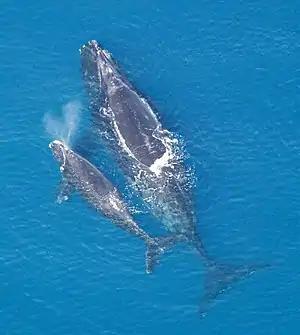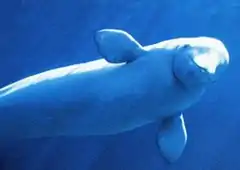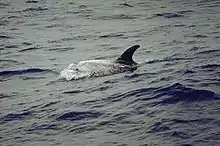List of mammals of Great Britain
This is a list of mammals of Great Britain. The mammal fauna of Great Britain is somewhat impoverished compared to that of Continental Europe due to the short period of time between the last ice age and the flooding of the land bridge between Great Britain and the rest of Europe. Only those land species which crossed before the creation of the English Channel and those introduced by humans exist in Great Britain.
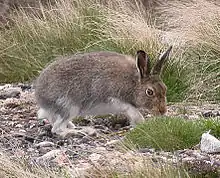
Native (usually synonymous with "indigenous") species are considered to be species which are today present in the region in question, and have been continuously present in that region since a certain period of time. When applied to Great Britain, three possible definitions of this time constraint are:
- a species that colonised the islands during the glacial retreat at the end of the last ice age (c. 9500 years ago);
- a species that was present when the English Channel was created (c. 8000 years ago); or,
- a species that was present in prehistory.
This list includes mammals from the small islands around Great Britain and the Channel Islands. There are no endemic mammal species in Great Britain, although four distinct subspecies of rodents have arisen on small islands.
The following tags are used to highlight the conservation status of each species' British population, as assessed by Natural England and The Mammal Society in a Regional Red List, following the criteria of the International Union for Conservation of Nature. This listing does not cover introduced species, marine species, or vagrants.[1]
| EX | Extinct | No reasonable doubt that the last individual has died. |
| EW | Extinct in the wild | Known only to survive in captivity or as a naturalised population well outside its previous range. |
| CR | Critically endangered | The species is in imminent risk of extinction in the wild. |
| EN | Endangered | The species is facing an extremely high risk of extinction in the wild. |
| VU | Vulnerable | The species is facing a high risk of extinction in the wild. |
| NT | Near threatened | The species does not meet any of the criteria that would categorise it as risking extinction but it is likely to in the future. |
| LC | Least concern | There are no current identifiable risks to the species. |
| DD | Data deficient | There is inadequate information to make an assessment of the risks to this species. |
Wallabies
Order: Diprotodontia
Though most marsupials make up a great part of the fauna in the Australian region, the red-necked wallaby has been introduced, and feral populations are currently breeding on the island of Inchconnachan on Loch Lomond in Argyll and Bute, Scotland, and on the Isle of Man. Other colonies have existed in Devon, the Peak District, and the Ashdown Forest in East Sussex, and although these are now believed to be locally extinct, occasional sightings continue.[2][3][4]
Family: Macropodidae (kangaroos, wallabies, and kin)
- Red-necked wallaby, Macropus rufogriseus LC introduced
Rodents
Family: Castoridae (beavers)
- Eurasian beaver, Castor fiber LC[5] reintroduced
Family: Cricetidae (voles)
- European water vole, Arvicola amphibius LC,[6] NT in Scotland, CR in Wales
- Field vole, Microtus agrestis LC
- Common vole, Microtus arvalis
- Orkney vole, M. a. orcadensis VU
- Bank vole, Myodes glareolus LC
Family: Muridae (rats, mice and relatives)
- Yellow-necked mouse, Apodemus flavicollis LC
- Wood mouse, Apodemus sylvaticus LC
- St Kilda field mouse, A. s. hirtensis
- Eurasian harvest mouse, Micromys minutus NT, LC in England, VU in Wales
- House mouse, Mus musculus LC[7]
- St Kilda house mouse, M. m. muralis EX
- Black rat, Rattus rattus LC[8] introduced[1]
- Brown rat, Rattus norvegicus LC introduced
Family: Gliridae (dormice)
- Edible dormouse, Glis glis LC introduced
- Hazel dormouse, Muscardinus avellanarius VU
Family: Sciuridae (squirrels)
- Eastern gray squirrel, Sciurus carolinensis LC introduced
- Red squirrel, Sciurus vulgaris LC[9] NT in Scotland
Rabbits and hares
Superorder: Euarchontoglires Order: Lagomorpha
The lagomorphs comprise two families, Leporidae (hares and rabbits), and Ochotonidae (pikas). Though they can resemble rodents, and were classified as a superfamily in that order until the early 20th century, they have since been considered a separate order. They differ from rodents in a number of physical characteristics, such as having four incisors in the upper jaw rather than two.
Family: Leporidae (hares and rabbits)
- European hare, Lepus europaeus LC[10] introduced
- Mountain hare, Lepus timidus NT, VU in England
- European rabbit, Oryctolagus cuniculus EN[11] introduced, LC in England, VU in Wales
Moles, shrews and hedgehogs
.jpg.webp)
Superorder: Laurasiatheria Order: Eulipotyphla
The order Eulipotyphla contains insectivorous mammals. The hedgehogs are easily recognised by their spines while gymnures look more like large rats. Shrews and solenodons closely resemble mice while the moles are stout-bodied burrowers.
Family: Talpidae (moles)
- European mole, Talpa europaea LC
Family: Soricidae (shrews)
- Lesser white-toothed shrew, Crocidura suaveolens NT
- Eurasian water shrew, Neomys fodiens LC
- Common shrew, Sorex araneus LC
- Eurasian pygmy shrew, Sorex minutus LC
Family: Erinaceidae (hedgehogs and gymnures)
- European hedgehog, Erinaceus europaeus VU[12]
Bats
Order: Chiroptera
The bats' most distinguishing feature is that their forelimbs are developed as wings, making them the only mammals capable of flight. Bat species account for about 20% of all mammals.
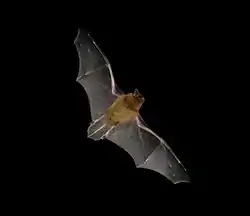
Family: Rhinolophidae (horseshoe bats)
- Lesser horseshoe bat, Rhinolophus hipposideros LC
- Greater horseshoe bat, Rhinolophus ferrumequinum LC, NT in Wales
Family: Vespertilionidae (common or vesper bats)
- Barbastelle, Barbastella barbastellus VU
- Serotine, Eptesicus serotinus VU
- Bechstein's bat, Myotis bechsteini LC,[13] EN in Wales
- Brandt's bat, Myotis brandti DD
- Daubenton's bat, Myotis daubentoni LC
- Greater mouse-eared bat, Myotis myotis LC[14]
- Whiskered bat, Myotis mystacinus DD
- Natterer's bat, Myotis nattereri LC
- Lesser noctule, Nyctalus leisleri LC[15]
- Common noctule, Nyctalus noctula LC[16]
- Nathusius pipistrelle, Pipistrellus nathusii LC[17] VU in Scotland and Wales
- Common pipistrelle, Pipistrellus pipistrellus LC
- Soprano pipistrelle, Pipistrellus pygmaeus LC
- Brown long-eared bat, Plecotus auritus LC
- Grey long-eared bat, Plecotus austriacus EN
- Parti-coloured bat, Vespertilio murinus LC
Carnivorans
Order: Carnivora
There are over 260 species of carnivorans, the majority of which feed primarily on meat. They have a characteristic skull shape and dentition.
.jpg.webp)
Family: Canidae (dogs)
- Gray wolf, Canis lupus LC extirpated
- Red fox, Vulpes vulpes LC,[18] NT in Scotland
Family: Ursidae (bears)
- Brown bear, Ursus arctos LC extirpated
Family: Mustelidae (weasels and relatives)
- Asian small-clawed otter, Aonyx cinereus VU introduced
- European otter, Lutra lutra LC,[19] VU in Scotland and Wales
- European pine marten, Martes martes LC,[20] CR in England and Wales
- European badger, Meles meles LC[21]
- Stoat, Mustela erminea LC,[22] NT in Wales
- Least weasel, Mustela nivalis LC[23]
- European polecat, Mustela putorius LC[24] EN in Scotland
- American mink, Neovison vison LC introduced
Family: Felidae (cats)
- European wildcat, Felis silvestris
- Scottish wildcat, F. s. silvestris [25] nationally CR, EX in England and Wales c. 1870[1][26]
- Eurasian lynx, Lynx lynx LC extirpated
Family: Phocidae (seals)
- Grey seal, Halichoerus grypus LC
- Common seal, Phoca vitulina LC
Even-toed ungulates
Order: Artiodactyla
The even-toed ungulates are ungulates whose weight is borne about equally by the third and fourth toes, rather than mostly or entirely by the third as in perissodactyls. There are about 220 artiodactyl species, including many that are of great economic importance to humans.
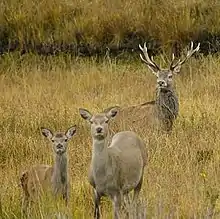
Family: Suidae (pigs)
- Wild boar, Sus scrofa NT, VU in England and Scotland, EN in Wales
Family: Cervidae (deer)
- Eurasian elk, Alces alces LC extirpated
- Roe deer, Capreolus capreolus LC[27]
- Red deer, Cervus elaphus LC
- Scottish red deer, C. e. scoticus
- Sika deer, Cervus nippon LC introduced
- Fallow deer, Dama dama LC introduced
- Chinese water deer, Hydropotes inermis LC introduced
- Reeves's muntjac, Muntiacus reevesi LC introduced
- Reindeer, Rangifer tarandus VU reintroduced
Whales and dolphins
Order: Cetacea
.jpg.webp)
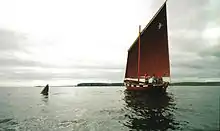
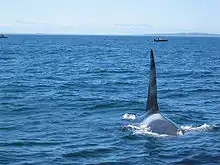
The infraorder Cetacea includes whales, dolphins and porpoises. They are the mammals most fully adapted to aquatic life with a spindle-shaped nearly hairless body, protected by a thick layer of blubber, and forelimbs and tail modified to provide propulsion underwater.
- Suborder: Mysticeti
- Family: Balaenidae
- Genus: Eubalaena
- North Atlantic right whale, Eubalaena glacialis CR(functionally extinct in eastern north Atlantic[28])
- Genus: Eubalaena
- Family: Balaenopteridae
- Subfamily: Balaenopterinae
- Genus: Balaenoptera
- Common minke whale, B. acutorostrata LC[29]
- Sei whale, B. borealis EN
- Blue whale, B. musculus EN[30]
- Fin whale, B. physalus NT
- Genus: Megaptera
- Humpback whale, Megaptera novaeangliae LC
- Genus: Balaenoptera
- Subfamily: Balaenopterinae
- Family: Balaenidae
- Suborder: Odontoceti
- Family: Phocoenidae
- Genus: Phocoena
- Harbour porpoise, Phocoena phocoena VU
- Genus: Phocoena
- Family: Physeteridae
- Genus: Physeter
- Sperm whale, Physeter macrocephalus VU
- Genus: Physeter
- Family: Kogiidae
- Genus: Kogia
- Pygmy sperm whale, K. breviceps DD[31]
- Genus: Ziphius
- Cuvier's beaked whale, Ziphius cavirostris DD
- Subfamily: Hyperoodontinae
- Genus: Hyperoodon
- Northern bottlenose whale, Hyperoodon ampullatus DD
- Genus: Mesoplodon
- Sowerby's beaked whale, Mesoplodon bidens DD
- Gervais' beaked whale, Mesoplodon europaeus DD
- True's beaked whale, Mesoplodon mirus DD
- Genus: Hyperoodon
- Genus: Kogia
- Family: Delphinidae (marine dolphins)
- Genus: Pseudorca
- False killer whale, Pseudorca crassidens NA
- Genus: Delphinus
- Short-beaked common dolphin, Delphinus delphis DD
- Genus: Tursiops
- Common bottlenose dolphin, Tursiops truncatus DD
- Genus: Stenella
- Striped dolphin, Stenella coeruleoalba DD
- Genus: Lagenorhynchus
- Atlantic white-sided dolphin, Lagenorhynchus acutus LC
- White-beaked dolphin, Lagenorhynchus albirostris LC
- Genus: Grampus
- Risso's dolphin, Grampus griseus DD
- Genus: Orcinus
- Genus: Pseudorca
- Family: Phocoenidae
See also
References
- Mathews, F.; Kubasiewicz, L. M.; Gurnell, J.; Harrower, C. A.; McDonald, R. A.; Shore, R. F. (2018). A Review of the Population and Conservation Status of British Mammals: Technical Summary. A report by the Mammal Society under contract to Natural England, Natural Resources Wales and Scottish Natural Heritage (PDF). Peterborough: Natural England. Retrieved 18 August 2019.
- "13 surprising animals you can spot in Britain". The Telegraph. 18 August 2018. Retrieved 21 August 2019.
- "Unexpected wild animals in Britain – part 1". Ordnance Survey. Retrieved 21 August 2019.
- Harris, Stephen; Morris, Pat; Wray, Stephanie; Yalden, Derek (1995). "A review of British mammals: population estimates and conservation status of British mammals other than cetaceans" (PDF). Joint Nature Conservation Committee. Archived from the original (PDF) on 13 September 2004. Cite journal requires
|journal=(help) - Batbold, J.; Batsaikhan, N.; Shar, S.; Hutterer, R.; Kryštufek, B.Yigit; N., Mitsain, G. & Palomo, L. (2016). "Castor fiber". IUCN Red List of Threatened Species. 2016: e.T4007A115067136.CS1 maint: multiple names: authors list (link)
- Batsaikhan, N.; Henttonen, H.; Meinig, H.; Shenbrot, G.; Bukhnikashvili, A.; Hutterer, R.; Kryštufek, B.; Yigit, N.; Mitsain, G. & Palomo, L. (2016). "Arvicola amphibius". IUCN Red List of Threatened Species. 2016: e.T2149A115060819.
- Musser, G.; Hutterer, R.; Kryštufek, B.; Yigit, N. & Mitsain, G. (2016). "Mus musculus". IUCN Red List of Threatened Species. 2016: e.T13972A115117618.
- Kryštufek, B.; Palomo, L.J.; Hutterer, R.; Mitsain, G. & Yigit, N. (2015). "Rattus rattus". IUCN Red List of Threatened Species. 2015: e.T19360A115148682.
- Amori, G.; Hutterer, R.; Kryštufek, B.; Yigit, N.; Mitsain, G. & Muñoz, L. J. P. (2010). "Sciurus vulgaris". IUCN Red List of Threatened Species. 2010: e.T20025A9136220.
- Hacklande, K. & Schai-Braun, S. (2019). "Lepus europaeus". IUCN Red List of Threatened Species. 2019: e.T41280A45187424.
- Villafuerte, R. & Delibes-Mateos, M. (2019). "Oryctolagus cuniculus". IUCN Red List of Threatened Species. 2019: e.T41291A45189779.
- Amori, G. (2016). "Erinaceus europaeus". IUCN Red List of Threatened Species. 2016: e.T29650A2791303.
- Paunović, M. (2019). "Myotis bechsteinii". IUCN Red List of Threatened Species. 2019: e.T14123A22053752.
- Coroiu, I.; Juste, J. & Paunović, M. (2016). "Myotis myotis". IUCN Red List of Threatened Species. 2016: e.T14133A22051759.
- Juste, J. & Paunović, M. (2016). "Nyctalus leisleri". IUCN Red List of Threatened Species. 2016: e.T14919A22016159.
- Csorba, G.; Hutson, A.M. (2016). "Nyctalus noctula". IUCN Red List of Threatened Species. 2016: e.T14920A22015682.
- Hutson, A. M.; Spitzenberger, F.; Juste, J.; Aulagnier, S.; Palmeirim, J.; Karatas, A. & Paunovic, M. (2010). "Pipistrellus nathusii". IUCN Red List of Threatened Species. 2010: e.T17316A6966886.
- Hoffmann, M.; Sillero-Zubiri, C. (2016). "Vulpes vulpes". IUCN Red List of Threatened Species. 2016: e.T23062A46190249.
- Roos, A.; Loy, A.; de Silva, P.; Hajkova, P.; Zemanová, B. (2015). "Lutra lutra". IUCN Red List of Threatened Species. 2015: e.T12419A21935287.
- Herrero, J.; Kranz, A.; Skumatov, D.; Abramov, A.V.; Maran, T.; Monakhov, V.G. (2016). "Martes martes". IUCN Red List of Threatened Species. 2016: e.T12848A45199169.
- Kranz, A.; Abramov, A. V.; Herrero, J. & Maran, T. (2016). "Meles meles". IUCN Red List of Threatened Species. 2016: e.T29673A45203002.
- Reid, F.; Helgen, K. & Kranz, A. (2016). "Mustela erminea". IUCN Red List of Threatened Species. 2016: e.T29674A45203335.
- McDonald, R. A.; Abramov, A. V.; Stubbe, M.; Herrero, J.; Maran, T.; Tikhonov, A.; Cavallini, P.; Kranz, A.; Giannatos, G.; Kryštufek, B. & Reid, F. (2019). "Mustela nivalis". IUCN Red List of Threatened Species. 2019: e.T70207409A147993366.
- Skumatov, D.; Abramov, A.V.; Herrero, J.; Kitchener, A.; Maran, T.; Kranz, A.; Sándor, A.; Stubbe, M.; Saveljev, A.; Savour-Soubelet, A.; Guinot-Ghestem, M.; Zuberogoitia, I.; Birks, J.D.S.; Weber, A.; Melisch, R. & Ruette, S. (2016). "Mustela putorius". IUCN Red List of Threatened Species. 2016: e.T41658A45214384.
- Kitchener, A.C.; Breitenmoser-Würsten, C.; Eizirik, E.; Gentry, A.; Werdelin, L.; Wilting, A.; Yamaguchi, N.; Abramov, A. V.; Christiansen, P.; Driscoll, C.; Duckworth, J. W.; Johnson, W.; Luo, S.-J.; Meijaard, E.; O'Donoghue, P.; Sanderson, J.; Seymour, K.; Bruford, M.; Groves, C.; Hoffmann, M.; Nowell, K.; Timmons, Z.; Tobe, S. (2017). "A revised taxonomy of the Felidae: The final report of the Cat Classification Task Force of the IUCN Cat Specialist Group" (PDF). Cat News. Special Issue 11: 16−20.
- Breitenmoser, U.; Lanz, T.; Breitenmoser-Würsten, C. (2019). Conservation of the wildcat (Felis silvestris) in Scotland: Review of the conservation status and assessment of conservation activities (PDF). IUCN SSC Cat Specialist Group.
- Lovari, S.; Herrero, J.; Masseti, M.; Ambarli, H.; Lorenzini, R. & Giannatos, G. (2016). "Capreolus capreolus". IUCN Red List of Threatened Species. 2016: e.T42395A22161386.
- "North Atlantic right whale".
- Cooke, J.G. (2018). "Balaenoptera acutorostrata". IUCN Red List of Threatened Species. 2018: e.T2474A50348265.
- "Blue Whale – Balaenoptera musculus". ORCA. Retrieved 14 October 2012.
- Taylor, B.L.; Baird, R.; Barlow, J.; Dawson, S.M.; Ford, J.K.B.; Mead, J.G.; Notarbartolo di Sciara, G.; Wade, P. & Pitman, R.L. (2012). "Kogia breviceps". IUCN Red List of Threatened Species. 2012: e.T11047A17692192.
- Reeves, R.; Pitman, R.L. & Ford, J.K.B. (2017). "Orcinus orca". IUCN Red List of Threatened Species. 2017: e.T15421A50368125.
External links
- Marshall, C. (2018). "One in five British mammals at risk of extinction". BBC News. Retrieved 18 August 2019.
- "Beavers given native species status after reintroduction to Scotland". The Guardian. 2016.
